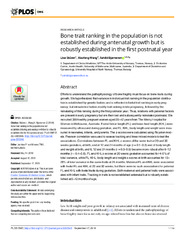Bone trait ranking in the population is not established during antenatal growth but is robustly established in the first postnatal year
Permanent link
https://hdl.handle.net/10037/14969Date
2018-09-17Type
Journal articleTidsskriftartikkel
Peer reviewed
Abstract
Efforts to understand the pathophysiology of bone fragility must focus on bone traits during growth. We hypothesized that variance in individual trait ranking in the population distribution is established by genetic factors and is reflected in foetal trait ranking in early pregnancy, but intrauterine factors modify trait ranking in late pregnancy, followed by the reinstating of this ranking during the first postnatal year. Thus, relations with paternal factors are present in early pregnancy but are then lost and subsequently reinstated postnatal. We recruited 399 healthy pregnant women aged 20–42 years from The Mercy Hospital for Woman in Melbourne, Australia. Foetal femur length (FL) and knee-heel length (KHL) were measured by ultrasound during gestation, and FL, KHL, body length and weight were measured in neonates, infants, and parents. The z-scores were calculated using Royston models. Pearson correlation was used to assess tracking and linear mixed models to test the associations. Correlations between FL and KHL z-scores of the same trait at 20 and 30 weeks gestation, at birth, and at 12 and 24 months of age (r = 0.1–0.3) and of body length and weight at birth, and 6, 12 and 24 months (r = 0.3–0.5) became more robust after 6–12 months (r = 0.4–0.8). FL and KHL z-scores at 20 weeks gestation accounted for 4–5% of total variance, while FL, KHL, body length and weight z-scores at birth accounted for 13–26% of total variance in the same traits at 24 months. Maternal FL and KHL were associated with foetal FL and KHL at 20 and 30 weeks, but there were no such associations for paternal FL and KHL with foetal traits during gestation. Both maternal and paternal traits were associated with infant traits. Tracking in traits is not established antenatal but is robustly established at 6–12 months of age.
Description
Source at https://doi.org/10.1371/journal.pone.0203945.


 English
English norsk
norsk